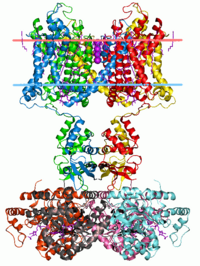
Photo from wikipedia
Fast C-type inactivation confers distinctive functional properties to the hERG potassium channel, and its association to inherited and acquired cardiac arrythmias makes the study of the inactivation mechanism of hERG… Click to show full abstract
Fast C-type inactivation confers distinctive functional properties to the hERG potassium channel, and its association to inherited and acquired cardiac arrythmias makes the study of the inactivation mechanism of hERG at the atomic detail of paramount importance. At present, two models have been proposed to describe C-type inactivation in K+-channels. Experimental data and computational work on the bacterial KcsA channel support the hypothesis that C-type inactivation results from a closure of the selectivity filter that sterically impedes ion conduction. Alternatively, recent experimental structures of a mutated Shaker channel revealed a widening of the extracellular portion of the selectivity filter, which might diminish conductance by interfering with the mechanism of ion permeation. Here, we performed molecular dynamics simulations of the wild-type hERG, a non-inactivating mutant (hERG-N629D), and a mutant that inactivates faster than the wild-type channel (hERG-F627Y) to find out which and if any of the two reported C-type inactivation mechanisms applies to hERG. Closure events of the selectivity filter were not observed in any of the simulated trajectories but instead, the extracellular section of the selectivity filter deviated from the canonical conductive structure of potassium channels. The degree of widening of the potassium binding sites at the extracellular entrance of the channel was directly related to the degree of inactivation with hERG-F627Y > wild-type hERG > hERG-N629D. These findings support the hypothesis that C-type inactivation in hERG entails a widening of the extracellular entrance of the channel rather than a closure of the selectivity filter.
Journal Title: Journal of Chemical Information and Modeling
Year Published: 2022
Link to full text (if available)
Share on Social Media: Sign Up to like & get
recommendations!